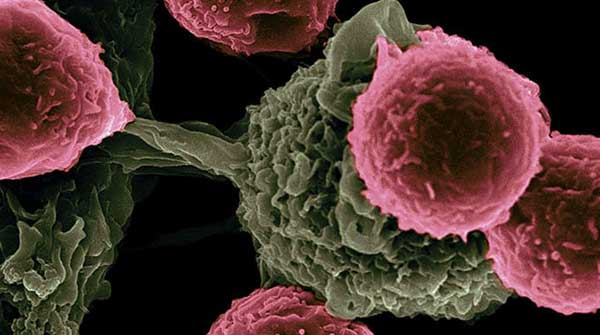Easier-to-produce compound for cancer diagnostic imaging is ready for patient use
For people waiting for imaging tests to diagnose neuroendocrine cancer, time is of the essence. Now a new medical imaging agent for PET scans promises to reduce wait times while costing less to produce and possibly revealing more of some types of cancer tumours.

Ralf Schirrmacher
Ralf Schirrmacher, an oncology imaging professor and member of the Cancer Research Institute of Northern Alberta, and his team at the Medical Isotope and Cyclotron Facility at the University of Alberta have been using a state-of-the-art cyclotron – a machine that already supplies the province with medical isotopes used in diagnostic scans – to create a new imaging compound that will reveal cancer tumours when patients receive a PET or PET-MRI scan.
The use of extremely low amounts of radioactive material as diagnostic “tracers” in cancer imaging is not new, but researchers are continually working on new chemistries to make these radiotracers safer, more reliable and more effective.
The new radiotracer, labelled with fluorine-18, is good at locating neuroendocrine tumours – cancerous tumours that can appear anywhere in the body but are most often found in the intestines, lungs, pancreas and stomach.
 |
| Related Stories |
| Radon: the silent killer lurking in your home
|
| Researchers engineering new drug to beat blood cancers
|
| New cookbook boosts protein diet to help people beat cancer |
Schirrmacher says fluorine-18 is an improvement compared to other currently used radioisotopes such as gallium-68. Radioactive gallium requires a special generator. In addition, there are often supply shortages, and the use of the gallium generator is restricted to a limited amount, which means only two to three patients a day can receive a medical scan.
“We are lucky: we have access to two AHS cyclotrons – one here at the U of A and one at the Cross Cancer Institute (in Edmonton) as well,” Schirrmacher, who is also a member of the Women and Children’s Health Research Institute, said. “We could make a batch in the morning and see 10 patients, so we could reduce the waiting time for patients substantially.”
Schirrmacher, a radiochemist, has been working on the compound since 2005; shortly thereafter he had the breakthrough idea to combine radioactive fluorine with silicon. It was previously only combined with carbon.
“The radioactive peptides are labelled capitalizing on the very strong bond between silicon and fluorine. The chemistry works at room temperature, and purification only requires one simple extraction and the imaging agent is ready for injection. This is why it is so stable and reliable,” he explained.
Schirrmacher is now happy to see his team’s work go from the chemistry lab bench to the bedside as clinical trials involving more than 2,000 people in Germany have been completed and are starting in the Netherlands, France, and India.
He says the clinical trials in Germany are showing that the new compound may actually catch more cancer metastasis than other gallium-labelled compounds, which is especially important in follow-up treatment and determining whether cancer is spreading to other parts of the body.
Next steps in Canada mean applying for clinical trials, which will go through the newly formed Alberta Radiopharmaceutical Centre, a collaboration between Alberta Health Services and the U of A.
Schirrmacher notes that he will not license the chemical process of creating the new imaging agent because he thinks it’s better that it is free for all to use so more people who may have cancer can get scanned sooner.
“I can’t imagine how it feels having cancer or not knowing if you have cancer, and then having to wait to get diagnostic imaging,” he says.
| By Ramona Czakert Franson
Ramona Czakert Franson is a reporter with the University of Alberta’s Folio online magazine. The University of Alberta is a Troy Media Editorial Content Provider Partner.
The opinions expressed by our columnists and contributors are theirs alone and do not inherently or expressly reflect the views of our publication.
© Troy Media
Troy Media is an editorial content provider to media outlets and its own hosted community news outlets across Canada.

